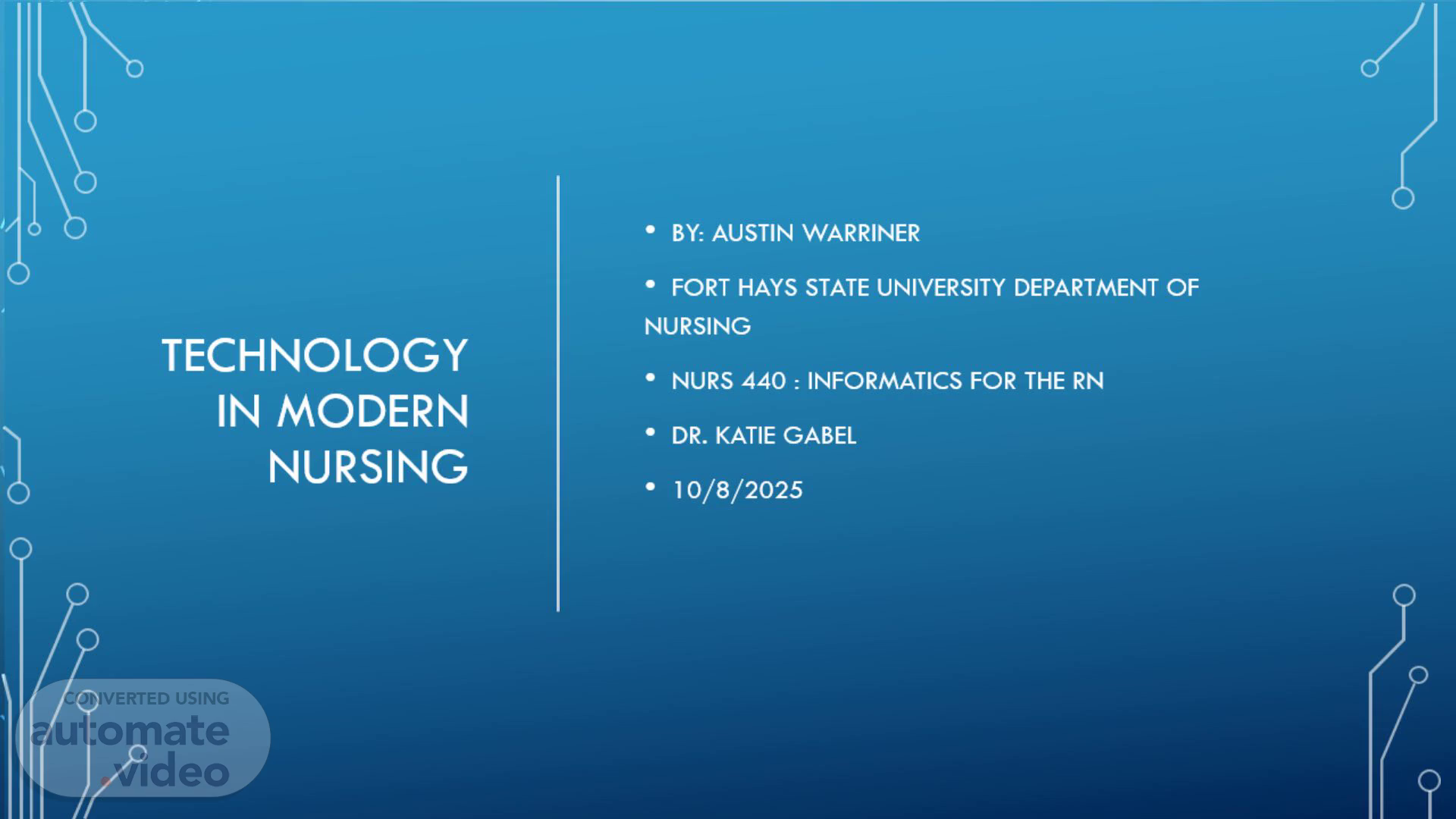Scene 1 (0s)
[Audio] Technology in modern nursing by Austin Warriner.
Scene 2 (12s)
[Audio] The types of technology that will be discussed will include the use of barcode medication administration systems, pupillometry in neuro critical care, and finally using SIRS criteria in electronic health records.
Scene 3 (18s)
[Audio] Now we will go over barcode medication administration systems, What is BCMA? BCMA is the use of barcode scanners to administer medications to patients safely in various settings. Benefits: Improved patient outcomes when used correctly by the user, hard stops with errors, and minimizing adverse drug events Cons: Costs, user training and implementation, downtime, and user adherence.
Scene 4 (48s)
[Audio] What does research tell us, The use of the BCMA system can be proven to prevent adverse drug events, increase efficiency for nurses, and ensure the patients' six medication rights. However, certain limitations presented in the study, including user compliance and overall correct use, concluded that it needs more research but was identified as beneficial.
Scene 5 (1m 13s)
[Audio] Now we will discuss pupillometry, Pupillometry in neurocritical care? This device can give exact measurements of pupil size and reaction time. Use: In near comatose patients with severe brain injury in place of subjective pupil assessments. Benefits: Exact measurements, reliability, and earlier assessments of decline in patient status. Cons: Price, training, and patient comfort as it is more invasive.
Scene 6 (1m 48s)
[Audio] What can be conclued from studies? According to studies, it is proven that this is used by multiple disciplines and is proven to be safer, more effective, and overall improves the earlier recognition of change in patient condition, especially in near comatose states, compared to using a pen light and using subjective measurements in patients with alteration to brain function It may also only be beneficial to units with specific patient populations to delineate some of the cons of this advanced technology..
Scene 7 (2m 22s)
[Audio] Finally I will discuss SIRS criteria in electronic health records and use of modified early warming system Systemic inflammatory response syndrome can be fatal in patients who go untreated or are not recognized. Utilizing EHRs to our advantage can help decrease the complications that can lead to sepsis. Using the EHR to screen data, specifically a Modified Early Warning System, which includes blood pressure, heart rate, temperature, respiratory rate, and oxygen saturation levels, will alert providers and nursing staff to escalate to a higher level of care or adjust treatment plans to prevent future complications.
Scene 8 (3m 4s)
[Audio] What are the results from real examples? When used at a certain inpatient hospital, it was found that the MEWS tool provided a visual representation of patient acuity and allowed for the timely recognition of a decline in patient status, thereby facilitating the escalation of care to intensive care for patients with a high MEWS score, which indicated SIRS via vitals. This benefited patients and prevented mortality.
Scene 9 (3m 33s)
[Audio] In summary Technology in nursing is crucial for benefiting nurses, patients, and physicians by preventing mistakes, complications, and costly errors. Although costly and can be extensive to implement in healthcare areas, it has proven to be beneficial in multiple disciplines. Multiple considerations need to be taken into account with new technology, including privacy, ethical, and cultural concerns..
Scene 10 (3m 58s)
[Audio] This presentation would be targeted to healthcare professionals, IT specialists, and informatics nurses in the hospital setting, specifically inpatient adult units like medical-surgical, intensive care, telemetry, etc..
Scene 11 (4m 15s)
[Audio] References. References. Kebapcı, A., & Topçu, S. (2020). Interrater reliability in pupillary assessment among intensive care nurses. Intensive & Critical Care Nursing, 58https://doi.org/10.1016/j.iccn.2020.102801 Lorenz, M. E., & Nawrocki, L. (2024). Improving Early Identification of Sepsis with a Modified Early Warning Score Review Tool. Medsurg Nursing, 33(6), 287-292. http://ezproxy.fhsu.edu:2048/login?url=https://www.proquest.com/scholarly-journals/improving-early-identification-sepsis-with/docview/3145231368/se-2 Williams, R., Kantilal, K., Man, K. K. C., Blandford, A., & Jani, Y. (2025). Barcode medication administration system use and safety implications: a data-driven longitudinal study supported by clinical observation. BMJ Health & Care Informatics, 32(1)https://doi.org/10.1136/bmjhci-2024-101214 Young, L. (2025, Spring). Technology Meets Quality: How Artificial Intelligence Can Enhance Dashboards for Quality Improvement. Journal of Informatics Nursing, 10(2), 61+. https://link-gale-com.ezproxy.fhsu.edu/apps/doc/A852371217/PPNU?u=klnb_fhsuniv&sid=bookmark-PPNU&xid=cdd54118.
